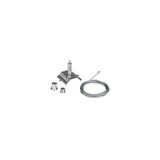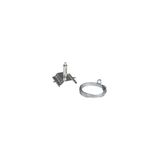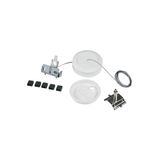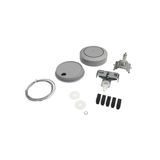Siteco LED strips, modules, profiles and accessories







siteco led strips and modules Range and application
Retail coves, museum cases, hospitality lines, and production benches all benefit from linear sources that hold color, run cool, and install fast. Siteco offers 24 V and 48 V constant-voltage strips plus constant-current boards in industry footprints, with lumen nodes ~300–4 000 lm/m, efficacies up to ~170 lm/W, CRI 80/90/95, and CCT 2 700–6 500 K (tunable white available on selected lines). Binning is tight for uniform runs; MacAdam ≤3 SDCM keeps seams invisible across long shelves and corridors. IP20 for interiors; IP65/67 encapsulated variants for damp or outdoor soffits.
siteco led profiles Options and thermal behavior
Profiles ship in shallow, deep, and asymmetric forms with clear, opal, and micro-prismatic covers. The extrusion height and mass are sized to keep board Tc below the TM-21 projection point—expect L80 50–60k h on light profiles and 70–100k h on heavier sections when the ambient is respected. End caps, joiners, and feed-through glands maintain IP and finish standards, and cut lengths are documented so millwork teams can pre-drill and avoid on-site trimming.
siteco linear lighting modules Optics and electrical interfaces
Rigid boards in 280/560/1120 mm steps land neatly in trunking and troffers; optics include Lambertian, narrow aisle, batwing, and double-asymmetric. Drivers pair via DALI-2 DT6/DT8 or 1–10 V; PF ≥0.90 and THD ≤10–15 % are typical on pro drivers. Flicker metrics meet office targets (PstLM ≤1.0, SVM ≤0.4). For high punch in retail, 90+ CRI with R9>50 holds reds; for back-of-house, 80 CRI saves budget without compromising task performance.
Design notes, standards, and durability
Boards reference EN 62031 with LM-80 source data and TM-21 life projections; assembled luminaires follow EN 60598. Thermal pads are specified; don’t substitute foam tape—conductance matters more than compression. Feed both ends on long CV runs to limit drop; at 24 V, plan ≤5 m per feed segment unless the copper cross-section is upsized. Where dimming goes to very low levels for galleries, document the minimum stable percent by driver, not just protocol.
Controls, segmentation, and optics
Addressable segments simplify aisle/daylight zoning. With DALI-2, keep bus headroom ≥20 % and cable length within guidance; with 1–10 V, publish min-level behavior so cleaners don’t work in semi-dark. Aisle optics reduce spill and lift Emin/Ē without adding watts; opal covers manage glare in offices while micro-prismatics keep UGR civil near screens.
Materials and environment
Aluminum extrusions double as heat sinks and alignment rails. Finish options include raw, anodized, and powder-coat; specify the same finish across a sightline to avoid color shift. For coastal or food environments, sealed joints, stainless screws, and silicone gaskets handle washdown and salt fog. Cable entries should match plate thickness—long-thread glands prevent star-cracking on composite ceilings.
siteco led mounting systems Installation details and load paths
Suspension kits (wire, rod) carry published SWL with 5:1 safety factors; ceiling clips snap into standard trunking and C-rails. Through-wiring harnesses are pre-terminated with push-in blocks; conductor windows 0.5…2.5 mm² suit loop-through on 10 A lighting circuits. Always keep 10–15 mm air each side of convection-cooled drivers; crowding raises Tc and voids life claims.
Applications and integration
Retail shelves: narrow beams for punch, opal for uniform price rails. Museums: high CRI, low flicker, and tunable white for conservation cues. Logistics aisles: asymmetric modules aligned along racking, presence plus daylight trim. Food prep: IP65 extrusions with tempered covers. When schedules mention siteco lighting accessories, include end-caps, joiners, corners, and sealed feeds on the same tag so installers finish in one pass. For long continuous lines, specify feed spacing, loop topology, and emergency segment logic up front.
Engineering checks before order
- Photometry: IES/LDT for each optic and lumen node.
- Electrical: inrush per channel, PF/THD, driver topology, loop current.
- Thermal: profile mass vs board watt density; Tc measurement point accessible.
- Mechanics: mounting pattern, screw size/torque, cover retention method.
- EMC: segregate VFD feeders; bond gland plates 360°.
- Safety: emergency flux files for 1–3 h modes; wiring diagrams for test switches
Procurement and site notes
Standardize two profile heights across a floor; spares and corners become interchangeable. Order spare diffusers and gaskets with the first drop—most late-night IP issues trace back to damaged covers. Pre-cut profiles arrive cleaner than on-site saws and save dust control headaches. For curved millwork, factory-bent rails outperform segmented joints in both look and labor.
Bankoflamps B2B advantages
We align optics, lumen nodes, driver sets, profiles, feeds, and controls to your room data sheets and single-lines, then show live EU stock by warehouse before access nights are booked. Quotes typically return in about an hour with EAN/MPN, Tc limits, PF/THD, inrush, IP/IK, and cut-plan codes—so selections don’t drift mid-phase. Your portal displays lead times, shipment status, and downloadable price lists with validity windows; approved clients can use post-payment up to 30 days. We consolidate by line/zone to trim freight and site sorting, and your account manager cross-checks feed distances, emergency zoning, DALI budgets, gland policy, and mounting hardware against drawings—so cartons arrive lift-ready and crews finish once.